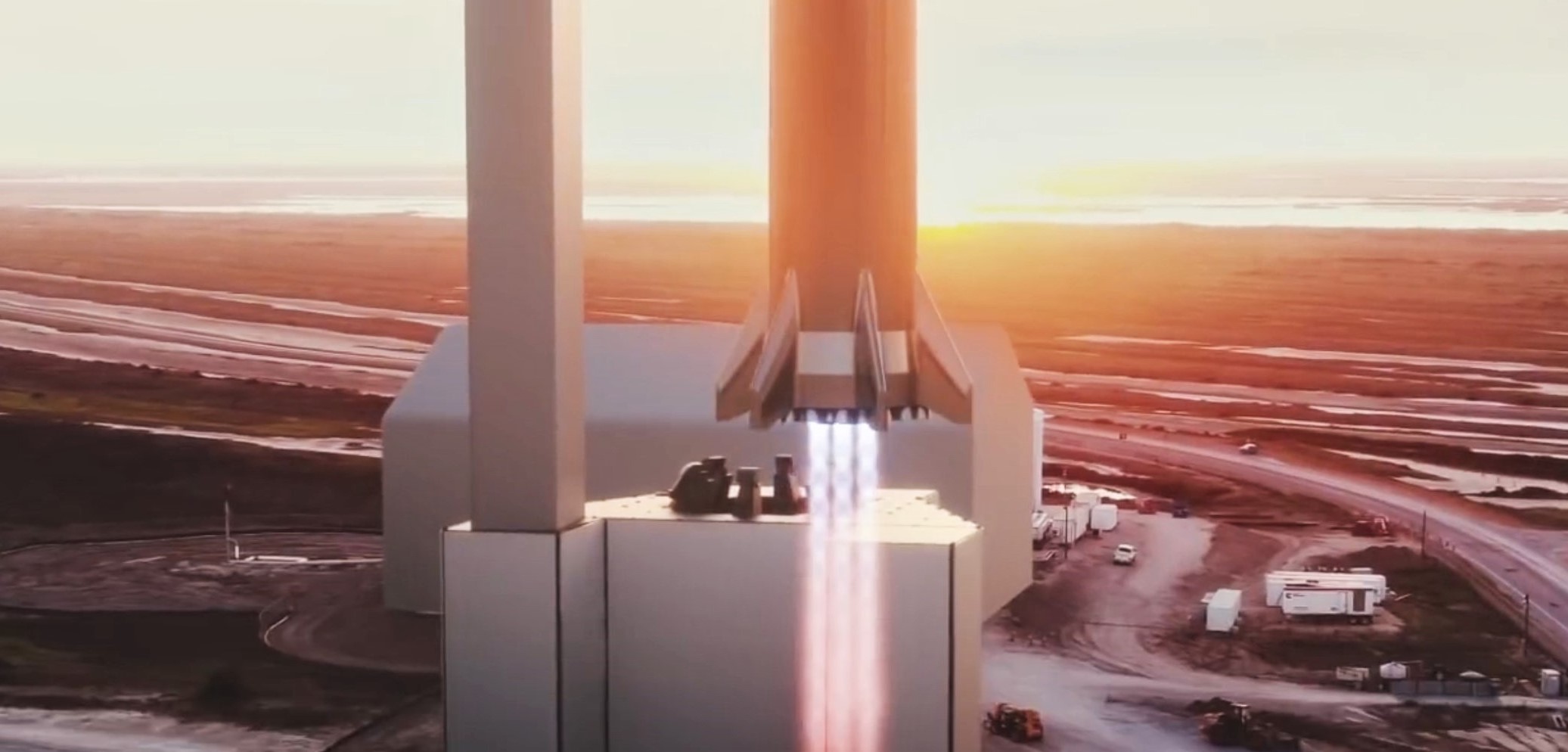
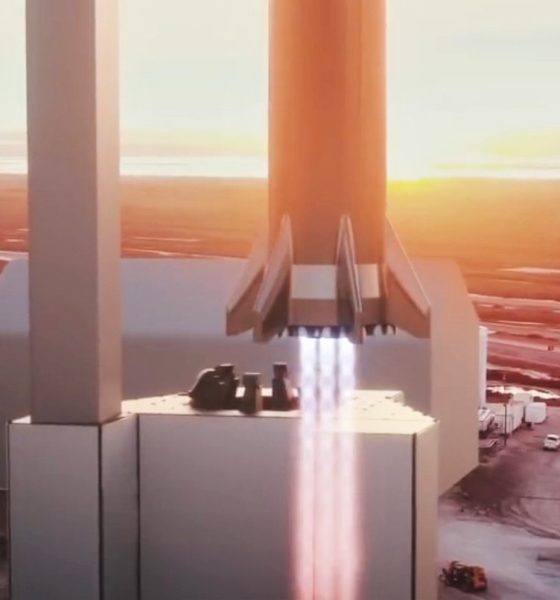
News
SpaceX begins Starship launch mount installation at historic Pad 39A in Florida
At the same time as SpaceX’s Boca Chica, Texas team is working around the clock to prepare Starship Mk1 for several major tests, the company is building a second dedicated Starship launch complex at Pad 39A and as of November 4th, that construction effort has reached a symbolic milestone.
According to photos taken by local resident and famed rocket and ship photographer Julia Bergeron on a bus tour of Kennedy Space Center (KSC), SpaceX has officially begun to install a large steel structure at Launch Complex 39A, a pad the company has leased from NASA since 2014. Known as a launch mount, the massive structure will one day support SpaceX’s first East Coast Starship and Super Heavy static fires and test flights.
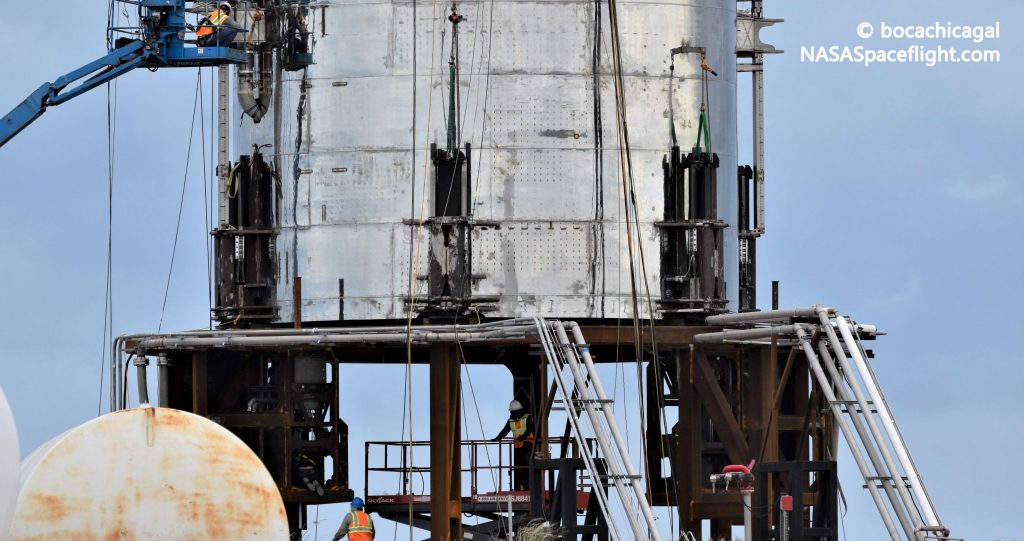
At SpaceX’s Boca Chica, Texas Starship facilities, the company has already made a huge amount of progress fabricating and outfitting a brand new launch mount that will soon support Starship Mk1’s first propellant loading, static fire, and flight tests. The spartan steel structure looks different from anything SpaceX has built in the past for Falcon 9 and is equally unrecognizable alongside the renders of a finished-product launch pad included in an updated Starship launch video.
What is undeniable, nevertheless, is the speed with which technicians have taken the Texas launch mount from a group of unconnected, partially-finished parts to a nearly complete structure with the business half of Starship Mk1 installed on top. SpaceX workers have built the mount, completed a large amount of plumbing to connect it to nearby liquid oxygen, methane, nitrogen, and helium reserves, and installed Starship on the mount in less than two months. The final integration of different prefabricated pieces began barely a month before Starship was moved to the pad, as pictured below.
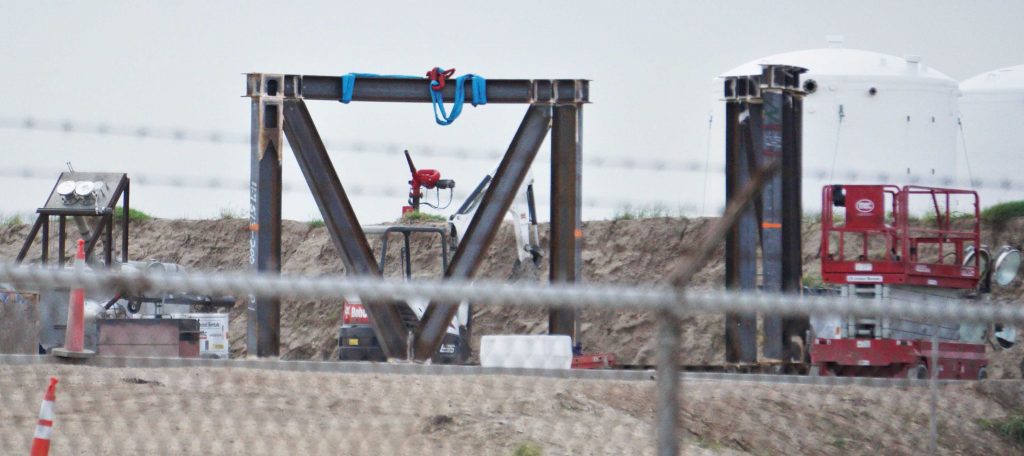
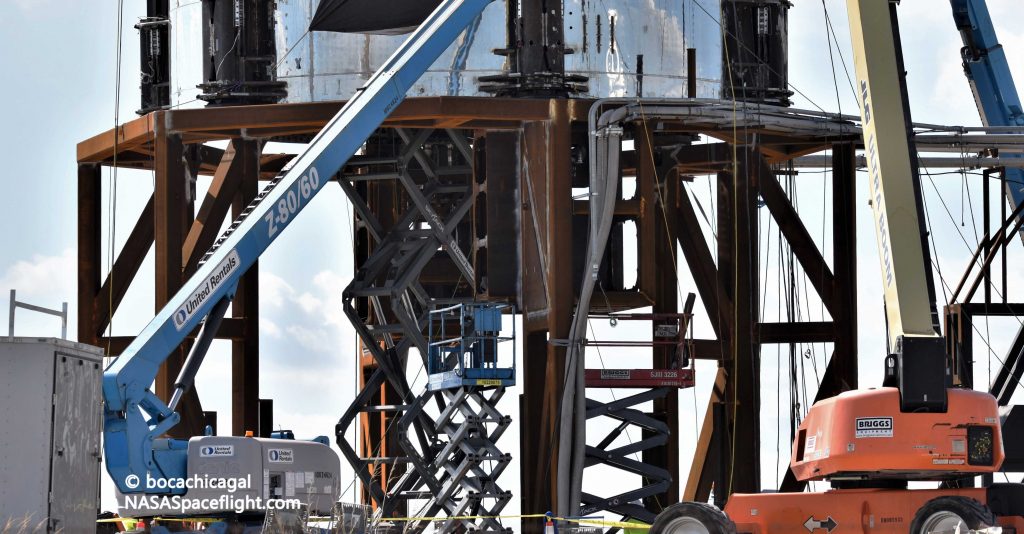
Two pads, two approaches
Although Boca Chica’s launch mount is quite large, based on Julia’s photos of Pad 39A, Florida’s nascent launch mount is going to be significantly bigger. The section that SpaceX began installing in the first days of November appears already be much taller than the mount in Texas, and it also looks more like a rectangular corner than anything resembling part of Boca Chica’s hexagonal structure.
At the same time, the apparent rectangular corner being worked on in Florida would be a much better fit for the partially-enclosed launch mount structure shown in SpaceX’s official 2019 Starship launch video.
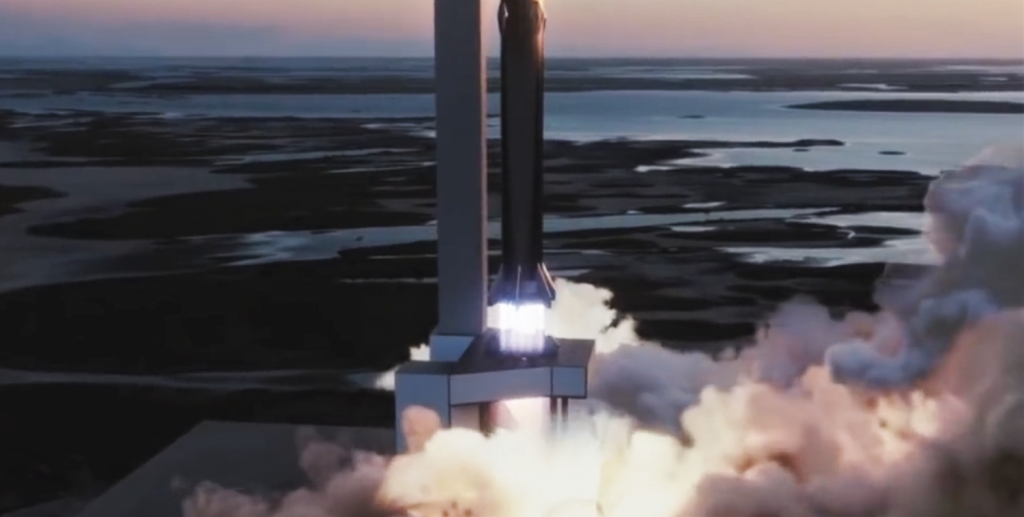
This is all to say that it looks like SpaceX is taking significantly different approaches with its two prospective Starship launch sites, which should come as no surprise in the context of the Starship program. SpaceX is already competitively building multiple Starship prototypes at two separate facilities in Boca Chica, Texas and Cocoa, Florida, a competition that has already produced visible differences between Mk1 and Mk2 prototypes. There’s a good chance that SpaceX intends to preserve that competitive atmosphere with Starship’s launch facilities, not just the rocket itself.
Additionally, it’s clear that Texas and Florida currently serve very different roles in the actual testing of Starship prototypes. Boca Chica has been active in that regard for more than half a year, ranging from the first Starhopper static fire in April to Starhopper’s 150-meter test flight in August. Florida has been almost entirely focused on iterating the build process itself and has already prefabricated nearly two dozen single-weld steel rings that will soon become Starship Mk4.
A step further, SpaceX CEO Elon Musk has made it clear that he is pushing for Starship’s first orbital launch to occur in the first half of 2020, an incredibly ambitious target given that the first Super Heavy booster prototype has yet to begin fabrication or assembly of any kind. Regardless, with that ambitious target in mind, SpaceX still needs to try to build a launch facility capable of standing up to a vehicle more powerful than Saturn V unfathomably quickly.
Head in the clouds
More likely than not, SpaceX’s Pad 39A Starship facilities will (attempt to) be that launch facility. An August 2019 environmental impact statement revealed that SpaceX would avoid Pad 39A’s massive flame trench and instead build a separate water-cooled thrust diverter, a technology SpaceX is extremely familiar with.
The diverter will likely have to be larger than anything SpaceX has ever attempted to build and will take a significant amount of time and money to fabricate, but the approach could potentially allow SpaceX to build Super Heavy-rated launch facilities from scratch in just 6-12 months. Put simply, however, SpaceX is not going to want to build a Starship-sized thrust diverter and launch mount in Florida if it will almost immediately have to build a second, larger replacement big enough for orbital launch attempts with Super Heavy.
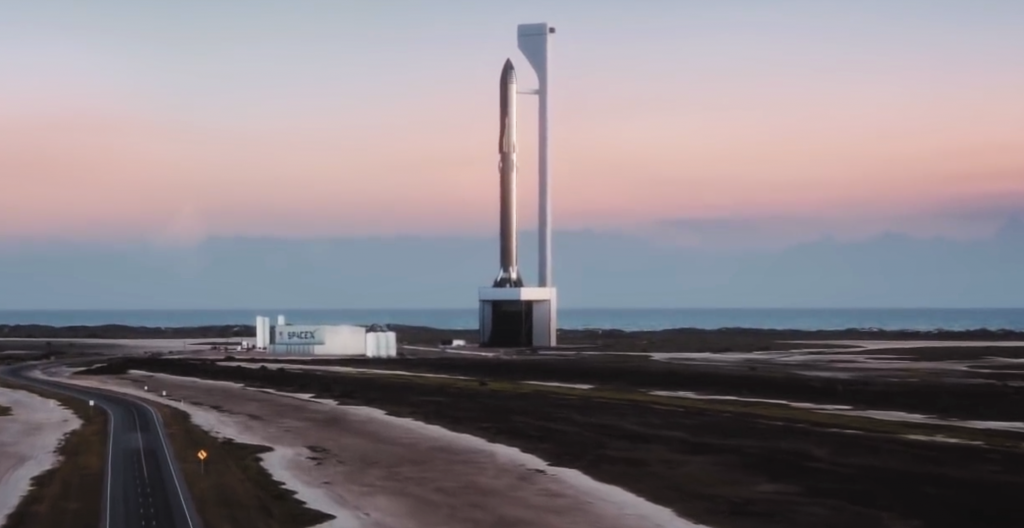
All things considered, it’s thus reasonably likely that SpaceX’s first draft of Florida Starship launch facilities will immediately jump to something sized for Super Heavy static fires and launches, even if that means it will take much longer to complete. If the pace of launch pad development in Boca Chica is anything to go by, it’s entirely possible that SpaceX will go from breaking ground at Pad 39A (mid-September 2019) to a more or less complete Starship-Super Heavy launch mount in roughly half a year.
Even if it takes more than a year to build, SpaceX could still be ready to attempt Starship’s first orbital launch well before the end of 2020.
Check out Teslarati’s Marketplace! We offer Tesla accessories, including for the Tesla Cybertruck and Tesla Model 3.

News
Tesla China delivery centers look packed as 2025 comes to a close
Needless to say, it appears that Tesla China seems intent on ending 2025 on a strong note.

Tesla’s delivery centers in China seem to be absolutely packed as the final days of 2025 wind down, with photos on social media showing delivery locations being filled wall-to-wall with vehicles waiting for their new owners.
Needless to say, it appears that Tesla China seems intent on ending 2025 on a strong note.
Full delivery center hints at year-end demand surge
A recent image from a Chinese delivery center posted by industry watcher @Tslachan on X revealed rows upon rows of freshly prepared Model Y and Model 3 units, some of which were adorned with red bows and teddy bears. Some customers also seem to be looking over their vehicles with Tesla delivery staff.
The images hint at a strong year-end push to clear inventory and deliver as many vehicles as possible. Interestingly enough, several Model Y L vehicles could be seen in the photos, hinting at the demand for the extended wheelbase-six seat variant of the best-selling all-electric crossover.
Strong demand in China
Consumer demand for the Model Y and Model 3 in China seems to be quite notable. This could be inferred from the estimated delivery dates for the Model 3 and Model Y, which have been extended to February 2026 for several variants. Apart from this, the Model Y and Model 3 also continue to rank well in China’s premium EV segment.
From January to November alone, the Model Y took China’s number one spot in the RMB 200,000-RMB 300,000 segment for electric vehicles, selling 359,463 units. The Model 3 sedan took third place, selling 172,392. This is quite impressive considering that both the Model Y and Model 3 are still priced at a premium compared to some of their rivals, such as the Xiaomi SU7 and YU7.
With delivery centers in December being quite busy, it does seem like Tesla China will end the year on a strong note once more.
News
Tesla Giga Berlin draws “red line” over IG Metall union’s 35-hour week demands
Factory manager André Thierig has drawn a “red line” against reducing Giga Berlin’s workweek to 35 hours, while highlighting that Tesla has actually increased its workers’ salaries more substantially than other carmakers in the country.

Tesla Giga Berlin has found itself in a new labor dispute in Germany, where union IG Metall is pushing for adoption of a collective agreement to boost wages and implement changes, such as a 35-hour workweek.
In a comment, Giga Berlin manager André Thierig drew a “red line” against reducing Giga Berlin’s workweek to 35 hours, while highlighting that Tesla has actually increased its workers’ salaries more substantially than other carmakers in the country.
Tesla factory manager’s “red line”
Tesla Germany is expected to hold a works council election in 2026, which André Thierig considers very important. As per the Giga Berlin plant manager, Giga Berlin’s plant expansion plans might be put on hold if the election favors the union. He also spoke against some of the changes that IG Metall is seeking to implement in the factory, like a 35-hour week, as noted in an rbb24 report.
“The discussion about a 35-hour week is a red line for me. We will not cross it,” Theirig said.
“(The election) will determine whether we can continue our successful path in the future in an independent, flexible, and unbureaucratic manner. Personally, I cannot imagine that the decision-makers in the USA will continue to push ahead with the factory expansion if the election results favor IG Metall.”
Giga Berlin’s wage increase
IG Metall district manager Jan Otto told the German news agency DPA that without a collective agreement, Tesla’s wages remain significantly below levels at other German car factories. He noted the company excuses this by referencing its lowest pay grade, but added: “The two lowest pay grades are not even used in car factories.”
In response, Tesla noted that it has raised the wages of Gigafactory Berlin’s workers more than their German competitors. Thierig noted that with a collective agreement, Giga Berlin’s workers would have seen a 2% wage increase this year. But thanks to Tesla not being unionized, Gigafactory Berlin workers were able to receive a 4% increase, as noted in a CarUp report.
“There was a wage increase of 2% this year in the current collective agreement. Because we are in a different economic situation than the industry as a whole, we were able to double the wages – by 4%. Since production started, this corresponds to a wage increase of more than 25% in less than four years,” Thierig stated.
News
Tesla is seeing a lot of momentum from young Koreans in their 20s-30s: report
From January to November, young buyers purchased over 21,000 Teslas, putting it far ahead of fellow imported rivals like BMW and Mercedes-Benz.

Tesla has captured the hearts of South Korea’s 20s-30s demographic, emerging as the group’s top-selling imported car brand in 2025. From January to November, young buyers purchased over 21,000 Teslas, putting it far ahead of fellow imported rivals like BMW and Mercedes-Benz.
Industry experts cited by The Economist attributed this “Tesla frenzy” to fandom culture, where buyers prioritize the brand over traditional car attributes, similar to snapping up the latest iPhone.
Model Y dominates among young buyers
Data from the Korea Imported Automobile Association showed that Tesla sold 21,757 vehicles to the 20s-30s demographic through November, compared to BMW’s 13,666 and Mercedes-Benz’s 6,983. The Model Y led the list overwhelmingly, with variants like the standard and Long Range models topping purchases for both young men and women.
Young men bought around 16,000 Teslas, mostly Model Y (over 15,000 units), followed by Model 3. Young women followed a similar pattern, favoring Model Y (3,888 units) and Model 3 (1,083 units). The Cybertruck saw minimal sales in this group.
The Model Y’s appeal lies in its family-friendly SUV design, 400-500 km range, quick acceleration, and spacious cargo, which is ideal for commuting and leisure. The Model 3, on the other hand, serves as an accessible entry point with lower pricing, which is valuable considering the country’s EV subsidies.
The Tesla boom
Experts described Tesla’s popularity as “fandom culture,” where young buyers embrace the brand despite criticisms from skeptics. Professor Lee Ho-geun called Tesla a “typical early adopter brand,” comparing purchases to iPhones.
Professor Kim Pil-soo noted that young people view Tesla more as a gadget than a car, and they are likely drawn by marketing, subsidies, and perceived value. They also tend to overlook news of numerous recalls, which are mostly over-the-air software updates, and controversies tied to the company.
Tesla’s position as Korea’s top import for 2025 seems secured. As noted by the publication, Tesla’s December sales figures have not been reported yet, but market analysts have suggested that Tesla has all but secured the top spot among the country’s imported cars this year.








